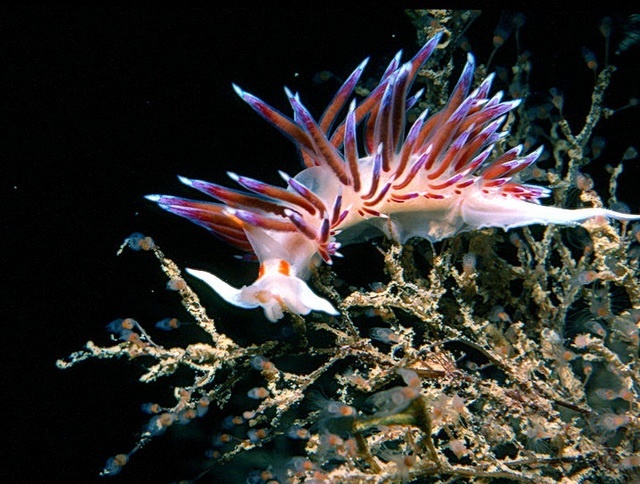Sea slug consumes the food of its prey
The diet of the pilgrim hervia Cratena peregrina, a sea slug, not only consists of the hydroids on which it lives; this animal also feeds on prey that was captured by the polyps, Trevor Willis and colleagues report.
The pilgrim hervia Cratena peregrina is a fairylike beautiful creature. Its white back bears tens of red protuberances with a luminescent blue tip, much like little candles. The sea slug occurs in the Mediterranean Sea and the eastern Atlantic Ocean on the branched colonies of hydroids such as Eudendrium ramosum and Eudendrium racemosum. The colonies provide shelter, the polyps are edible and possess defensive weapons that are useful. And according to Trevor Willis and colleagues, there is even more: the polyps capture food which the sea slug then may steal and consume.
Hydroids are cinidarians, just like jellyfish, and their mouth is surrounded by tentacles which grasp their prey, mainly zooplankton. They also possess stinging cells that are able to eject a harpoon (nematocyst) with a toxic content to paralyze prey or to deter predators from attacking.
Cnidosacs
But the pilgrim hervia is not deterred. It devours polyps without being bothered by stinging cells, as has already been known for a long time. In one way or another it is protected against injury by nematocysts that are fired while it is feeding, and many nematocysts that are ingested remain undischarged. Undischarged harpoons are not digested, but remain structurally intact while passing through the digestive system; some of them are discarded in the faeces, but others are sequestered and stored in cellular vesicles (cnidosacs) at the tips of the dorsal appendages.
So, the sea slug incorporates its prey’s weapons, and it can use them to frighten off hungry fish predators. Because of the bright aposematic coloration, predators quickly learn not to touch this beautiful but unpalatable morsel.
Prey of prey
Now, Willis shows that Cratena peregrina not only obtains second hand weapons from the hydroids, but also takes the prey that the polyps have captured. Laboratory experiments revealed that the sea slugs preferentially feed on polyps that are handling prey, for instance brine shrimp. By doing so, the sea slug ingests two food types in one bite: its prey and its prey’s prey. The second hand food, zooplankton, appears to be a substantial part of its diet – and the sea slug doesn’t have to capture this mobile prey by himself.
Willy van Strien
Photo: Cratena peregrina on Eudendrium ramosum. Français (Wikimedia Commons, public domain)
Watch the sea slug on YouTube
Sources:
Willis, T.J., K.T.L. Berglöf, R.A.R. McGill, L. Musco, S. Piraino, C.M. Rumsey, T.V. Fernández & F. Badalamenti, 2017. Kleptopredation: a mechanism to facilitate planktivory in a benthic mollusc. Biology Letters 13: 20170447. Doi: 10.1098/rsbl.2017.0447
Greenwood, P.G., 2009. Acquisition and use of nematocysts by cnidarian predators. Toxicon 54: 1065-1070. Doi:10.1016/j.toxicon.2009.02.029
Aguado, F. & A. Marin, 2007. Warning coloration associated with nematocyst-based defences in aeolidiodean nudibranchs. Journal of Molluscan Studies 73: 23-28. Doi:10.1093/mollus/eyl026
Martin, R., 2003. Management of nematocysts in the alimentary tract and in cnidosacs of the aeolid nudibranch gastropod Cratena peregrina. Marine Biology 143: 533-541. Doi: 10.1007/s00227-003-1078-8
